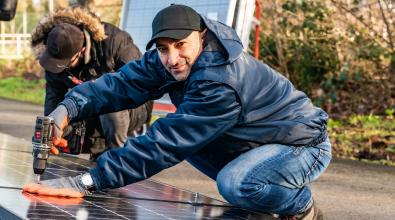 Read More
Read More
What does the future hold for public procurement? We ask the experts

Listen to This Article
Public procurement in cities, a foundational local government function, is undergoing a significant transformation. Traditionally focused on compliance and administrative tasks, it is increasingly becoming a strategic tool that anticipates and meets residents' needs while aligning with broader city priorities. And it's now playing a key role in enabling "mission-based innovation" to tackle major challenges from climate to hunger to equity.
London's Camden borough, which is pursuing four missions around food, young people, diversity, and neighborhoods, illustrates just some of the possibilities cities can unlock through using procurement as a strategic tool. For instance, Camden is exploring how to use engagement with local market actors to actively ensure its supplier base is strategically aligned with the borough’s goals. And it has tested impact-oriented frameworks, which can use defined mission outcomes to ensure that every procurement decision advances the borough's broader missions.
And that's just the beginning of what's next. Here's a closer look at what some experts say is possible with procurement in the near future—and how leaders can connect it to the innovative practices that are already making a difference in cities today.
Employing new technologies to build trust—and drive change.
As municipalities continue to level up their citywide data capacities, they will have new opportunities to make every dollar count—including by responsibly deploying artificial intelligence in procurement work.
“AI will facilitate spend analysis and support strategic decisions that are now obscured by the lack of data or its excess,” says Albert Sanchez Graells, a professor of economic law and co-director of the Centre for Global Law and Innovation at the University of Bristol Law School. Particular applications, he explains, could include anticipating areas of concern in contract approvals, or models that help predict the need for supplies to assemble infrastructure and keep up with population growth.
Already, local and regional officials making use of artificial intelligence are demonstrating what’s possible. Cities like Amsterdam—which has been supported by the Bloomberg Philanthropies innovation team (i-team) program—have taken the lead in modeling best practices for the responsible procurement of AI products. And AI is starting to be used to supercharge the procurement process itself, with procurement teams in states like Michigan and Tennessee exploring applications such as predictive models that help improve forecasting of project timelines, and generative A.I. that writes scopes of work for potential contracts.
All of these use cases require guardrails. But in some ways, what Graells is most excited about with artificial intelligence-fueled procurement is how it could push cities to do even better with data capacity. “If the willingness to deploy AI is a driver for improving procurement data... that will change things,” Graells says.
Accelerating citywide sprints on priorities.
In 2022, Portland officials announced a new initiative to invest in low-carbon concrete in future projects. It was the latest sign of leadership from one of the few U.S. cities with a staffer tasked specifically with incorporating sustainability into all procurements.
That approach speaks to how procurement teams are getting ready to take the lead in tackling some of the greatest challenges facing cities and their residents. And climate will likely be chief among them.
Ruairi Macdonald is an expert on procurement at the University of Oxford Law School who’s working on a project called Sustainable Procurement Applied Research and Knowledge Sharing. He believes cities’ transition away from fossil fuels will require procurement professionals to make a massive leap in their own capacities and begin working much more closely with sustainability officers.
When they do, the potential levers for procurement teams to help cut emissions include requiring suppliers to publish their own plans for achieving carbon neutrality—or even evaluating their emissions during past contracts—and cities building in-house tools to assess the “greenness” of bids for contracts.
A new study points to another potential application of a climate focus: using predictive models to help procure information technology equipment with an eye toward minimizing emissions and waste, work that could be relevant in cities everywhere.
Regardless of the approach, getting to where procurement teams need to be “means workflows will have to change,” Macdonald says.
Using public-facing procurement to strengthen faith in government.
All of these things demonstrate that procurement has the potential to change how governments do business in the coming years. And at the local level, that means an opportunity to put it front-and-center to highlight how city hall is delivering for residents.
“Beyond administering [only] the procurement process, procurement staff can, and will, take on more public-facing roles,” explains Kailey Burger Ayogu, managing director of procurement and economic mobility at the Harvard Kennedy School Government Performance Lab (GPL) and a veteran of local-government procurement herself.
In Miami, procurement staff—who have benefited from participating in GPL’s Procurement Excellence Network—are already demonstrating their evolving role. Last year, they joined forces with fire, emergency management, and police departments to distribute hurricane kits to elderly and low-income residents. This sort of collaboration not only brings procurement teams to the forefront, but it also signals a shift towards more strategic, visible involvement in city operations.
Going forward, procurement teams will help demonstrate mayors’ all-of-government approaches to improved service delivery. This means taking a much more active role in resident feedback sessions and uplifting their teams’ purchases and other contributions at public events.
“These community connections boost morale in procurement offices,” Burger Ayogu says. “But they also help residents see the people behind the curtain making things happen in their communities, demystifying the procurement process.”
She adds, “This, in turn, can help build social solidarity, as residents will feel a greater stake in their city's purchases—and feel more involved in charting their local future.”

